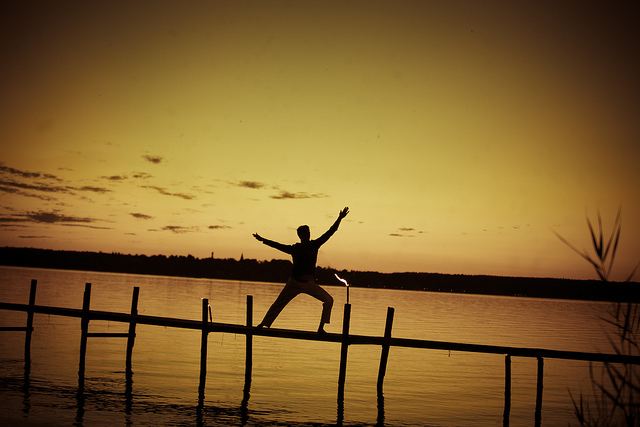Talk therapy (Cognitive behavioral therapy) is considered the number one most effective treatment for PTSD right now. Some veterans have also found art therapy or creating structure through a daily routine helpful. Anti-anxiety medication can be effective, but it can also become addictive so it’s not a good option for a long-term solution.
When I experienced PTSD after a house fire that left me homeless, I tried a holistic approach — and it worked. Here’s what I did.
1. Avoid stimulants like sugar and caffeine. Sugar and caffeine are anxiety-provoking. They get the mind racing, stress the adrenal glands, put the nervous system on edge, add to paranoia and make the heart beat faster. I was already experiencing these symptoms with PTSD, I didn’t need something within my control to make it worse. I traded caffeinated drinks for herbal teas, and once symptoms subsided, I opted for the lesser caffeinated decaf black, Chai and green teas. If you’re a soda drinker, try flavored seltzer instead. Water with lemon or lime is another good substitute. For a sweet fix, grab a piece of whole fruit instead of fruit juices and junk food. These choices will spare adding to the stress of PTSD symptoms, and support your overall health by boosting your diet with antioxidants, vitamins and better hydration. You’ll also balance your blood sugar, which affects your emotional state.
3. Consider energy therapy like Reiki or acupuncture. Energy healing stopped the persistent nightmares and alleviated heavy emotions that burdened me. It took months of sessions to feel on-going results. My sessions with a seasoned healer included talking about how I felt and what I was experiencing. Energy therapy was the calm in the storm, the healing that addressed my body, mind and spirit. Veterans have told me that energy balancing exercises like Tai Chi and QiGong are also extremely helpful. I also found regular massages a great asset to help my body and mind relax.
 4. Re-program your mind with positive, grounding statements. PTSD programmed my mind to believe the world was frightening and I wasn’t safe. I was convinced something really bad was going to happen again. I walked around on edge, prepared for that next life-threatening danger, protecting myself from the next unexpected attack. I was dissociated, floating somewhere outside of my body. When I broke away from the automatic pilot of survival mode and became mindful about my thoughts I was able to question their validity. I was able to consciously choose new beliefs like I am safe, and good things can happen. When a PTSD thought stressed my mind, I interrupted it with a positive thought that affirmed my safety. I constantly reminded me that the traumatic experience was in the past, and I was in a different place now, I was okay. I had to give myself permission to move on and trust it was safe to be present. To help heal dissociation, I practiced being present whenever I felt myself drifting. When I was in the car and felt myself spacing out, I said aloud, “My hands are on the steering wheel. I’m driving to work. I’m passing the sports store. I’m approaching a light.” This present awareness self-talk helped snap me out of the numbness and gently bring myself back into my body.
4. Re-program your mind with positive, grounding statements. PTSD programmed my mind to believe the world was frightening and I wasn’t safe. I was convinced something really bad was going to happen again. I walked around on edge, prepared for that next life-threatening danger, protecting myself from the next unexpected attack. I was dissociated, floating somewhere outside of my body. When I broke away from the automatic pilot of survival mode and became mindful about my thoughts I was able to question their validity. I was able to consciously choose new beliefs like I am safe, and good things can happen. When a PTSD thought stressed my mind, I interrupted it with a positive thought that affirmed my safety. I constantly reminded me that the traumatic experience was in the past, and I was in a different place now, I was okay. I had to give myself permission to move on and trust it was safe to be present. To help heal dissociation, I practiced being present whenever I felt myself drifting. When I was in the car and felt myself spacing out, I said aloud, “My hands are on the steering wheel. I’m driving to work. I’m passing the sports store. I’m approaching a light.” This present awareness self-talk helped snap me out of the numbness and gently bring myself back into my body.
 5. Practice yoga therapy. PTSD disrupts neurotransmitters that regulate stress and fear responses. It stresses adrenal glands that produce survival hormones that put you on edge, cortisol and adrenaline. The nervous system gets locked into a hyper state, making you feel on edge, heightening anxiety with the slightest change in environment. You may find yourself flinch at sudden movements and jump at loud noises. My number one therapy healing PTSD was gentle and restorative yoga. At first, I practiced fast moving Vinyasas, sun salutes, to work out anxiety and anger. But cardio isn’t good for intensely stressed states, it only wears down the adrenals glands more and stimulates an overstimulated nervous system. I turned to gentle yoga instead, focusing on slowing down my movements and being present. I gently and mindfully stretched emotional tension out of my body. I asked myself, where am I holding this emotional stress today? I’d locate it in my back, or knees and sometimes my neck, jaw and shoulders. I’d pay extra attention to stretching these parts. I’d try to spend at least 5 minutes in a restorative yoga position, and worked my way up to 10, 15 and 20 as I became more comfortable with lying still and simply being.
5. Practice yoga therapy. PTSD disrupts neurotransmitters that regulate stress and fear responses. It stresses adrenal glands that produce survival hormones that put you on edge, cortisol and adrenaline. The nervous system gets locked into a hyper state, making you feel on edge, heightening anxiety with the slightest change in environment. You may find yourself flinch at sudden movements and jump at loud noises. My number one therapy healing PTSD was gentle and restorative yoga. At first, I practiced fast moving Vinyasas, sun salutes, to work out anxiety and anger. But cardio isn’t good for intensely stressed states, it only wears down the adrenals glands more and stimulates an overstimulated nervous system. I turned to gentle yoga instead, focusing on slowing down my movements and being present. I gently and mindfully stretched emotional tension out of my body. I asked myself, where am I holding this emotional stress today? I’d locate it in my back, or knees and sometimes my neck, jaw and shoulders. I’d pay extra attention to stretching these parts. I’d try to spend at least 5 minutes in a restorative yoga position, and worked my way up to 10, 15 and 20 as I became more comfortable with lying still and simply being.
When I taught active duty soldiers fresh off deployments, we only did gentle and restorative yoga. They didn’t want any more physical challenges. They wanted rest. They wanted a refuge from the constant moving and change. They wanted the challenge of becoming more mindful, making a conscious mind/body connection and healing from within. At first, lying still may be extremely difficult. This is a sign that your nervous system is jacked up! Have patience. Consistent practice will calm your nervous system, help you breathe deeper and help you feel safe in your body again.
A certified yoga therapist, Lauralyn Kearney founded Yoga for Heroes to teach and counsel veterans, first responders and those serving the greater good. She established the first therapeutic yoga program for the U.S. Army at Fort Bragg helping active duty soldiers heal stress and injuries. Also a reiki master and spiritual counselor, Kearney specializes in holistic healing and promoting inner peace, and has been featured on national television. To learn more, visit: www.LauralynKearney.com, or visit Yoga for Heroes on Facebook.





















